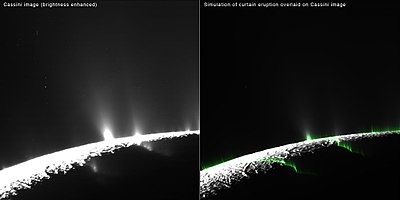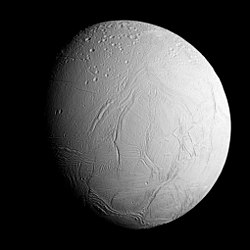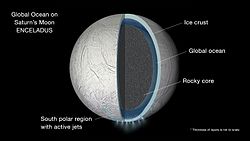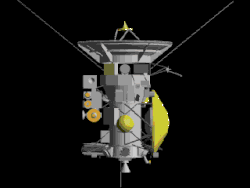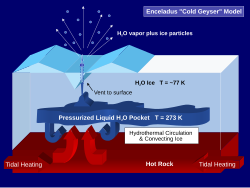PIA17191-SaturnMoon-Enceladus-TendrilSims-20150414
This collage, consisting of two Cassini images of long, sinuous, tendril-like features from Saturn's moon Enceladus and two corresponding computer simulations of the same features, illustrates how well the structures, and the sizes of the particles composing them, can be modeled by tracing the trajectories of tiny, icy grains ejected from Enceladus' south polar geysers.
The figures labeled "a" and "c" (see annotated image above) are computer-enhanced images of the tendril structures near Enceladus that were taken at high solar phase angle (174 and 170 degrees, respectively); figures "b" and "d" are synthetic (computer-generated) images produced by following the trajectories of tiny, icy particles ejected from the 36 most active geysers (representing the top 50 percent of the moon's total geysering activity) found on the south polar terrain. The match between real and synthetic images is quite good and strongly supports the suggestion that tendrils are produced by the moon's geysers.
Electromagnetic effects associated with electrical charges that collect on small grains embedded in a magnetosphere like Saturn's can modify the grains' trajectories. These effects are very sensitive to particle size, with smaller particles feeling the effects of charging more strongly than larger ones. The scale of the arc-like structures seen in the tendrils allows scientists to determine that the tendril particles are no smaller than about 0.5 microns (a micron is one millionth of a meter), a size consistent with that of E-ring particles found from other Cassini observations, both imaging and in situ.
Figure "a" is from the observation of 2006; "c" was taken on July 19, 2013 during Cassini's Earth-imaging event (see PIA17172). Orbital motion is counter-clockwise in all images.
The Cassini mission is a cooperative project of NASA, ESA (the European Space Agency) and the Italian Space Agency. The Jet Propulsion Laboratory, a division of the California Institute of Technology in Pasadena, manages the mission for NASA's Science Mission Directorate, Washington. The Cassini orbiter and its two onboard cameras were designed, developed and assembled at JPL. The imaging operations center is based at the Space Science Institute in Boulder, Colorado.
For more information about the Cassini-Huygens mission visit http://saturn.jpl.nasa.gov and http://www.nasa.gov/cassini. The Cassini imaging team homepage is at http://ciclops.org.Relevantní obrázky
Relevantní články
Enceladus (měsíc)Enceladus je šestý největší měsíc planety Saturn. Měsíc má v průměru téměř 500 kilometrů, což je přibližně desetina velikosti největšího měsíce Saturnu, Titanu. Enceladus je z většiny pokryt mladým a relativně čistým ledem, který odráží téměř veškeré sluneční světlo dopadající na jeho povrch. To má za následek extrémně nízkou teplotu povrchu pohybující se okolo -198 °C. I přes jeho malou velikost se na Enceladu nachází celá řada povrchových útvarů od starších oblastí silně posetých impaktními krátery po novější útvary vzniklé v posledních 100 milionech let. Rozsáhlou geologickou aktivitu vyvolávají patrně slapové síly planety Saturn, podobně jako u Jupiterových měsíců Io a Europa, protože vlastní významné zdroje tepla z radioaktivního rozpadu Enceladus s ohledem na svou velikost mít nemůže. Předpokládá se, že k zahřívání přispívá i rezonanční vazba Enceladu s měsícem Dione v poměru 1 : 2, což vyvolává uvnitř obou měsíců dodatečné slapové síly, a spolupůsobit může i měsíc Mimas. Vliv slapových sil by však nestačil k roztavení ledu, proto se vědci domnívají, že nitro Enceladu musí obsahovat i jiné těkavé látky s nízkým bodem varu. Na ledovém povrchu lze rozpoznat nejméně pět různých typů terénů: četné deformace, trhliny a prolákliny, ale jen málo impaktních kráterů, z nichž jsou mnohé přetvořené plastickým tečením povrchových vrstev měsíce. Největší kráter má průměr asi 35 km. Z jejich absence je tak zřejmé, že povrch je relativně mladý. .. pokračovat ve čtení



